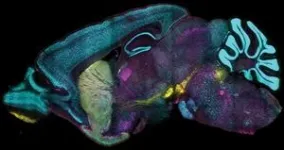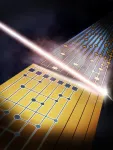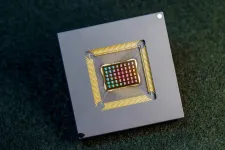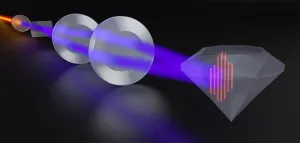(Press-News.org) A new technology developed at MIT enables scientists to label proteins across millions of individual cells in fully intact 3D tissues with unprecedented speed, uniformity, and versatility. Using the technology, the team was able to richly label whole rodent brains and other large tissue samples in a single day. In their new study in Nature Biotechnology, they also demonstrate that the ability to label proteins with antibodies at the single-cell level across whole brains can reveal insights left hidden by other widely used labeling methods.
Profiling the proteins that cells are making is a staple of studies in biology, neuroscience and related fields because the proteins a cell is expressing at a given moment can reflect the functions the cell is trying to perform or its response to its circumstances, such as disease or treatment. As much as microscopy and labeling technologies have advanced, enabling innumerable discoveries, scientists have still lacked a reliable and practical way of tracking protein expression at the level of millions of densely packed individual cells in whole, 3D intact tissues such as an entire mouse brain or a full region of a human brain. Often confined to thin tissue sections under slides, scientists therefore haven’t had tools to thoroughly appreciate cellular protein expression in the whole, connected systems in which it occurs.
“Conventionally, investigating the molecules within cells requires dissociating tissue into single cells or slicing it into thin sections, as light and chemicals required for analysis cannot penetrate deep into tissues. Our lab developed technologies such as CLARITY and SHIELD, which enable investigation of whole organs by rendering them transparent, but we now needed a way to chemically label whole organs to gain useful scientific insights” said study senior author Kwanghun Chung, associate professor in The Picower Institute for Learning and Memory, the Departments of Chemical Engineering and Brain and Cognitive Sciences, and the Institute for Medical Engineering and Science at MIT. “Imagine marinating a thick steak by simply dipping it in sauce. The outer layers absorb the marinade quickly and intensely, while the inner layers remain largely untouched unless the meat is soaked for an extended period. The same principle applies to chemical processing of tissues: if cells within a tissue are not uniformly processed, they cannot be quantitatively compared. The challenge is even greater for protein labeling, as the chemicals we use for labeling are hundreds of times larger than those in marinades. As a result, it can take weeks for these molecules to diffuse into intact organs, making uniform chemical processing of organ-scale tissues virtually impossible and extremely slow.”
The new approach, called “CuRVE,” represents a major advance—years in the making—toward that goal by demonstrating a fundamentally new approach to uniformly processing large and dense tissues whole. In the study, the researchers explain how they overcame the technical barriers via an implementation of CuRVE called “eFLASH,” and provide copious vivid demonstrations of the technology, including how it yielded new neuroscience insights.
“This is a significant leap, especially in terms of the actual performance of the technology,” said co-lead author Dae Hee Yun, a former MIT graduate student and now a senior application engineer at LifeCanvas Technologies, a startup company Chung founded to disseminate the tools his lab invents. The paper’s other lead author is Young-Gyun Park, a former MIT postdoctoral researcher now an assistant professor at KAIST in South Korea.
Clever chemistry
The fundamental reason why large, 3D tissue samples are hard to label uniformly is that antibodies seep into tissue very slowly, but are quick to bind to their target proteins. The practical effect of this speed mismatch is that simply soaking a brain in a bath of antibodies will mean that proteins are intensely well labeled on the outer edge of the tissue, but virtually none of the antibodies will find cells and proteins deeper inside.
To improve labeling, the team conceived of a way—the conceptual essence of CuRVE—to resolve the speed mismatch. The strategy was to continuously control the pace of antibody binding while at the same time speeding up antibody permeation throughout the tissue. To figure out how this could work and to optimize the approach, they built and ran a sophisticated computational simulation that enabled them to test different settings and parameters, including different binding rates and tissue densities and compositions.
Then they set out to implement their approach in real tissues. Their starting point was a previous technology, called “SWITCH,” in which Chung’s lab devised a way of temporarily turning off antibody binding, letting the antibodies permeate the tissue, and then turning binding back on. As well as it worked, Yun said, the team realized there could be substantial improvements if antibody binding speed could be controlled constantly, but the chemicals used in SWITCH were too harsh for such ongoing treatment. So the team screened a library of similar chemicals to find one that could more subtly and continuously throttle antibody binding speed. They found that deoxycholic acid was an ideal candidate. Using that chemical, the team could not only modulate antibody binding by varying the chemical’s concentration, but also by varying the labeling bath’s PH (or acidity).
Meanwhile, to speed up antibody movement through tissues, the team used another prior technology invented in the Chung Lab: stochastic electrotransport. That technology accelerates the dispersion of antibodies through tissue by applying electric fields.
Implementing this eFLASH system of accelerated dispersion with continuously modifiable binding speed produced the wide variety of labeling successes demonstrated in the paper. In all, the team reported using more than 60 different antibodies to label proteins in cells across whole brains of mice and rats; whole mouse embryos; other whole mouse organs including lung and heart; and blocks of brain tissue from larger animals including humans.
Notably, each of these specimens were labeled within a day, an “ultra-fast” speed for whole, intact organs, the authors said. Moreover, different preparations did not require new optimization steps.
Valuable visualizations
Among the ways the team put eFLASH to the test was by comparing their labeling to another often-used method: genetically engineering cells to fluoresce when the gene for a protein of interest is being transcribed. The genetic method doesn’t require dispersing antibodies throughout tissue, but it can be prone to discrepancies because reporting gene transcription and actual protein production are not exactly the same thing. Yun added that while antibody labeling reliably and immediately reports on the presence of a target protein, the genetic method can be much less immediate and persistent, still fluorescing even when the actual protein is no longer present.
In the study the team employed both kinds of labeling simultaneously in samples. Visualizing the labels that way, they saw many examples in which antibody labeling and genetic labeling differed widely. In some areas of mouse brains, they found that two-thirds of the neurons expressing PV (a protein prominent in certain inhibitory neurons) according to antibody labeling, did not show any genetically-based fluorescence. In another example, only a tiny fraction of cells that reported expression via the genetic method of a protein called ChAT also reported it via antibody labeling. In other words, there were cases where genetic labeling both severely underreported or overreported protein expression compared to antibody labeling.
The researchers don’t mean to impugn the clear value of using the genetic reporting methods, but instead suggest that also using organ-wide antibody labeling, as eFLASH allows, can help put that data in a richer, more complete context. For instance, given that they saw cases of significant over-reporting of PV expression in mice (and significant variation among individual mice), researchers who use whole-brain antibody labeling of PV could gain a deeper basis for analyzing genetically indicated changes in the protein.
“Our discovery of large regionalized loss of PV-immunoreactive neurons in healthy adult mice and with high individual variability emphasizes the importance of holistic and unbiased phenotyping,” the authors wrote.
Or as Yun put it, the two different kinds of labeling are, “two different tools for the job.”
In addition to Yun, Park and Chung, the paper’s other authors are Jae Hun Cho, Lee Kamentsky, Nicholas Evans, Nicholas DiNapoli, Katherine Xie, Seo Woo Choi, Alexandre Albanese, Yuxuan Tian, Chang Ho Sohn, Qiangge Zhang, Minyoung Kim, Justin Swaney, Webster Guan, Juhyuk Park, Gabi Drummond, Heejin Choi, Luzdary Ruelas, and Guoping Feng.
Funding for the study came from the Burroughs Wellcome Fund, the Searle Scholars Program, a Packard Award in Science and Engineering, a NARSAD Young Investigator Award, the McKnight Foundation, the Freedom Together Foundation, The Picower Institute for Learning and Memory, the NCSOFT Cultural Foundation and the National Institutes of Health.
END
MIT method enables protein labeling of tens of millions of densely packed cells in organ-scale tissues
Tissue processing advance can label proteins at the level of individual cells across whole, intact rodent brains and other large samples just as fast and uniformly as in dissociated single cells.
2025-01-24
ELSE PRESS RELEASES FROM THIS DATE:
Calculating error-free more easily with two codes
2025-01-24
Computers also make mistakes. These are usually suppressed by technical measures or detected and corrected during the calculation. In quantum computers, this involves some effort, as no copy can be made of an unknown quantum state. This means that the state cannot be saved multiple times during the calculation and an error cannot be detected by comparing these copies. Inspired by classical computer science, quantum physics has developed a different method in which the quantum information is distributed across several entangled quantum bits and stored redundantly in this ...
Dissolving clusters of cancer cells to prevent metastases
2025-01-24
Certain tumour types do not remain at their point of origin but spread throughout the body and form metastases. This is because the primary tumour continuously releases cancer cells into the blood. These circulating tumour cells (CTCs) can join together into small clusters of up to a dozen cells and settle in other organs. There, the clusters grow into larger tumours, known as metastases. Metastatic tumours are still a major medical problem: every year, around seven million people worldwide die from them.
One example of such a spreading tumour is breast cancer. As soon ...
A therapeutic HPV vaccine could eliminate precancerous cervical lesions
2025-01-24
PHILADELPHIA – A therapeutic vaccine targeting human papillomavirus type 16 (HPV16) induced regression in high-grade precancerous cervical lesions, according to the results from a phase II clinical trial published in Clinical Cancer Research, a journal of the American Association for Cancer Research.
“Nearly all premalignant cervical lesions and cervical cancers are caused by HPV infection, with HPV16 implicated in the majority of cases,” said Refika Yigit, MD, principal investigator and oncological gynecologist at University Medical Centre Groningen in the ...
Myth busted: Healthy habits take longer than 21 days to set in
2025-01-24
We’re nearly one month into 2025, but if you’re struggling to hold onto your New Year’s resolution, stay strong, as University of South Australia research shows that forming a healthy habit can take longer than you expect.
In the first systematic review of its kind, UniSA researchers found that new habits can begin forming within about two months (median of 59–66 days) but can take up to 335 days to establish.
It’s an important finding that could inform health interventions to ...
Development of next-generation one-component epoxy with high-temperature stability and flame retardancy
2025-01-24
Two-component epoxies, which require mixing resin and curing agent before use, often suffer from issues such as mixing ratio errors, limited working times, and inconsistent curing. Additionally, they must be used immediately after mixing, leading to wasted residue. To address these challenges, one-component epoxies have gained attention. One-component epoxies come pre-mixed, making them easy to use, reducing processing time, and ensuring consistent quality without mixing. In particular, using latent curing agents allows curing to be triggered only under specific conditions (e.g., heat or UV exposure), significantly improving storage stability. However, ...
Scaling up neuromorphic computing for more efficient and effective AI everywhere and anytime
2025-01-24
Neuromorphic computing—a field that applies principles of neuroscience to computing systems to mimic the brain’s function and structure—needs to scale up if it is to effectively compete with current computing methods. In a review published Jan. 22 in the journal Nature, 23 researchers, including two from the University of California San Diego, present a detailed roadmap of what needs to happen to reach that goal. The article offers a new and practical perspective toward approaching the cognitive capacity of the human brain with comparable form factor and power consumption.
“We ...
Make it worth Weyl: engineering the first semimetallic Weyl quantum crystal
2025-01-24
An international team of researchers led by the Strong Correlation Quantum Transport Laboratory of the RIKEN Center for Emergent Matter Science (CEMS) has demonstrated, in a world’s first, an ideal Weyl semimetal, marking a breakthrough in a decade-old problem of quantum materials.
Weyl fermions arise as collective quantum excitations of electrons in crystals. They are predicted to show exotic electromagnetic properties, attracting intense worldwide interest. However, despite the careful study of thousands of crystals, most ...
Exercise improves brain function, possibly reducing dementia risk
2025-01-24
A study led by scientists at Rutgers University-New Brunswick has shown that specialized cells involved in how the body responds to insulin are activated in the brain after exercise, suggesting that physical activity may directly improve brain function.
A study, published in Aging Cell, a journal focused on the biology of aging, indicates that therapies targeting this insulin action may be developed to offset or even prevent dementia progression.
“We believe this work is important because it suggests exercise may work to improve cognition and memory by improving the abilities of insulin to act on the brain,” ...
Diamonds are forever—But not in nanodevices
2025-01-24
Ultrawide-bandgap semiconductors—such as diamond—are promising for next-generation electronics due to a larger energy gap between the valence and conduction bands, allowing them to handle higher voltages, operate at higher frequencies, and provide greater efficiency compared to traditional materials like silicon. However, their unique properties make it challenging to probe and understand how charge and heat move on nanometer-to-micron scales. Visible light has a very limited ability to probe nanoscale properties, and moreover, it is not absorbed ...
School-based program for newcomer students boosts mental health, research shows
2025-01-24
The first randomized control trial of the school-based intervention called Supporting Transition Resilience of Newcomer Groups (STRONG) shows significant reductions in depression, anxiety and behavior problems among refugee and immigrant students. The study, funded by the National Institute of Mental Health, was co-led by Ann & Robert H. Lurie Children’s Hospital of Chicago and Loyola University, in partnership with the Chicago Public Schools (CPS). Results were published in the American Journal of Community Psychology. Key findings are summarized ...
LAST 30 PRESS RELEASES:
Exploring how the visual system recovers following injury
Support for parents with infants at pediatric check-ups leads to better reading and math skills in elementary school
Kids’ behavioral health is a growing share of family health costs
Day & night: Cancer disrupts the brain’s natural rhythm
COVID-19 vaccination significantly reduces risk to pregnant women and baby
The role of vaccination in maternal and perinatal outcomes associated with COVID-19 in pregnancy
Mayo Clinic smartwatch system helps parents shorten and defuse children's severe tantrums early
Behavioral health spending spikes to 40% of all children’s health expenditures, nearly doubling in a decade
Digital cognitive behavioral treatment for generalized anxiety disorder
Expenditures for pediatric behavioral health care over time and estimated family financial burden
Air conditioning in nursing homes and mortality during extreme heat
The Alps to lose a record number of glaciers in the next decade
What makes a good proton conductor?
New science reporting guide published for journalists in Bulgaria
New international study reveals major survival gaps among children with cancer
New science reporting guide published for journalists in Turkey
Scientists develop a smarter mRNA therapy that knows which cells to target
Neuroanatomy-informed brain–machine hybrid intelligence for robust acoustic target detection
Eight SwRI hydrogen projects funded by ENERGYWERX
The Lundquist Institute and its start-up company Vitalex Biosciences Announces Strategic Advancement of Second-Generation fungal Vaccine VXV-01 through Phase 1 Trials under $40 Million Competitive Con
Fine particles in pollution are associated with early signs of autoimmune disease
Review article | Towards a Global Ground-Based Earth Observatory (GGBEO): Leveraging existing systems and networks
Penn and UMich create world’s smallest programmable, autonomous robots
Cleveland researchers launch first major study to address ‘hidden performance killer’ in athletes
To connect across politics, try saying what you oppose
Modulating key interaction prevents virus from entering cells
Project explores barriers to NHS career progression facing international medical graduates
Jeonbuk National University researchers explore the impact of different seasonings on the flavor perception of Doenjang soup
Two Keck Medicine of USC Hospitals named Leapfrog Top Teaching Hospitals
World-first discovery uncovers how glioblastoma tumours dodge chemotherapy, potentially opening the door to new treatments
[Press-News.org] MIT method enables protein labeling of tens of millions of densely packed cells in organ-scale tissuesTissue processing advance can label proteins at the level of individual cells across whole, intact rodent brains and other large samples just as fast and uniformly as in dissociated single cells.






